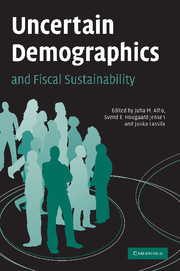Book contents
- Frontmatter
- Contents
- List of figures
- List of tables
- List of contributors
- Preface
- 1 Introduction
- Part I Uncertain demographics
- Part II Measuring sustainability in a stochastic environment
- Part III Enhancing sustainability
- Part IV Extensions
- 10 Macro-economic consequences of demographic uncertainty in world regions
- 11 Informational assumptions, aggregate mortality risk and life-cycle saving
- 12 Uncertain demographics, longevity adjustment of the retirement age and intergenerational risk-sharing
- 13 A general equilibrium analysis of annuity rates in the presence of aggregate mortality risk
- Comment: The economics of demographic uncertainty
- Index
- References
11 - Informational assumptions, aggregate mortality risk and life-cycle saving
Published online by Cambridge University Press: 22 September 2009
- Frontmatter
- Contents
- List of figures
- List of tables
- List of contributors
- Preface
- 1 Introduction
- Part I Uncertain demographics
- Part II Measuring sustainability in a stochastic environment
- Part III Enhancing sustainability
- Part IV Extensions
- 10 Macro-economic consequences of demographic uncertainty in world regions
- 11 Informational assumptions, aggregate mortality risk and life-cycle saving
- 12 Uncertain demographics, longevity adjustment of the retirement age and intergenerational risk-sharing
- 13 A general equilibrium analysis of annuity rates in the presence of aggregate mortality risk
- Comment: The economics of demographic uncertainty
- Index
- References
Summary
Introduction
The primary motivation of models discussed in this volume is the need to quantify the effects of policy measures on, for example, the pension system. Stylized models are preferred for qualitative insight (Diamond, 2001), but cannot provide precise estimates for policy formulation. The price one has to pay for the realism is the relative complexity of the models. The models are not analytically tractable and even a description of their computational solution is involved. We discuss here a related model that deals with decision-making in the presence of uncertainty about future mortality rates. While our model does not allow for analytical solutions either, it is transparent in terms of what is being optimized and permits an analysis of more general informational assumptions than the complex models used to analyse pension problems. In discussing the model we have the following three issues in mind.
First, studies of the use of population forecasts in decision-making suggest that while the uncertainty of forecasts is readily acknowledged by both the users and producers of forecasts (Alho, Cruijsen and Keilman, this volume, chap. 3), there is considerable inertia in the adoption of new methods. Cohort-component forecasts of population have been produced in many European countries since the 1920s and 1930s (Alho and Spencer, 2005). Since that time, alternative forecast variants have typically been offered, but the users have almost invariably considered the middle variant only. As discussed by Alho, Cruijsen and Keilman (this volume, chap. there is considerable inertia in the adoption of new methods.
- Type
- Chapter
- Information
- Uncertain Demographics and Fiscal Sustainability , pp. 219 - 238Publisher: Cambridge University PressPrint publication year: 2008
References
- 2
- Cited by



